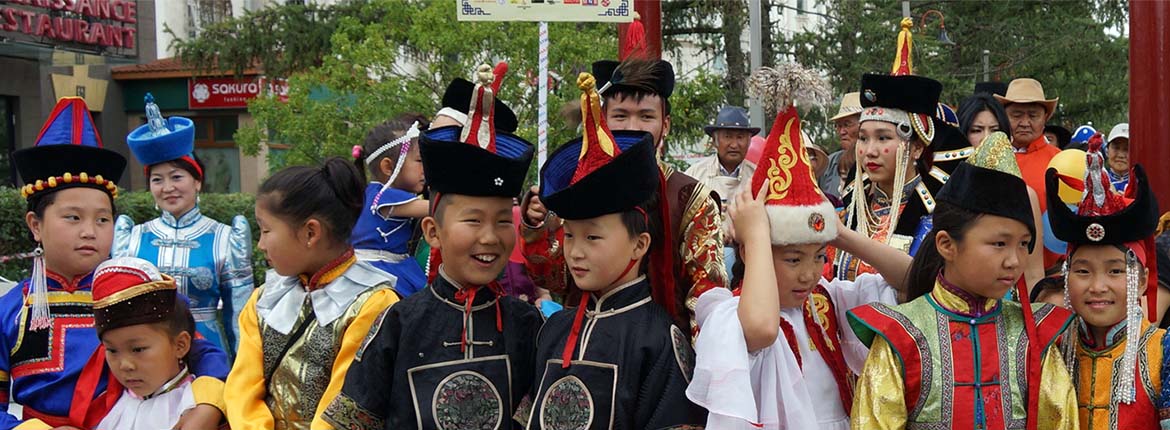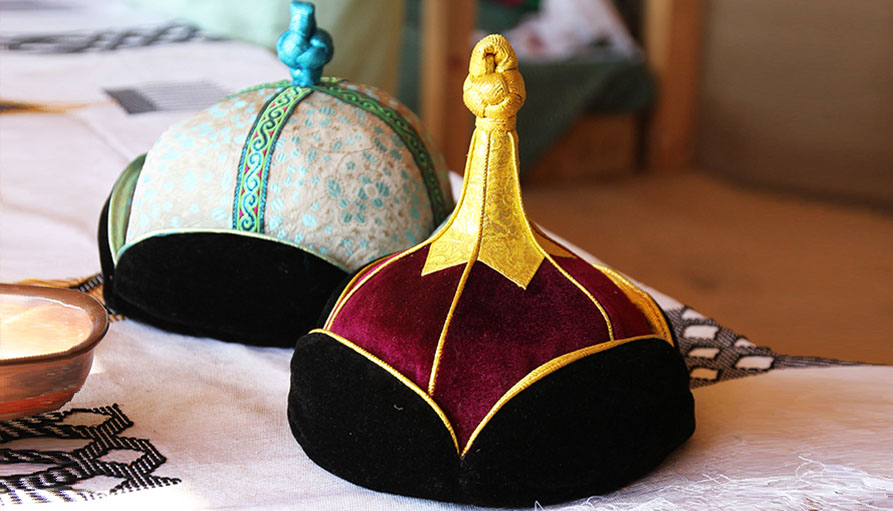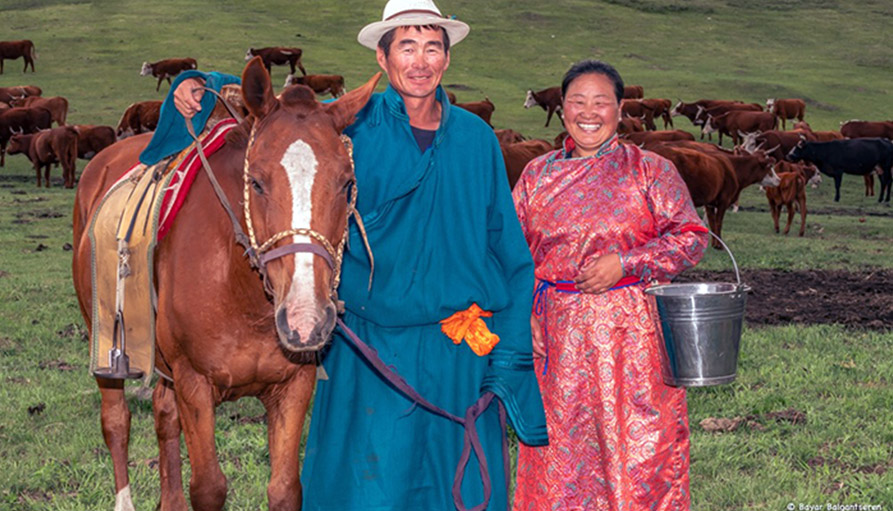
Mongolian Traditional Clothes
The traditional dress of the Mongols has a rich history spanning many centuries. It is closely connected with the Mongolian way of life and the country. The costumes of elderly people are, as a rule, modest and plain. The female dress shows differences between the attire of the girls and that of married women. The nomads' wardrobe is compact but has many variations able to serve different purposes. "It is amazing how this nation invented clothes that can fit all seasons and needs, well thought off and used in many different ways," wrote Medieval travelers from Europe.
THE MONGOLIAN TRADITIONAL COSTUME CONSISTS OF HAT, DEEL, BOOTS AND ACCESSORIES.
Hats
One of the most colorful and original items of Mongolian national dress is the traditional headwear. The Mongolian headdresses differed in shape and purpose; there were hats for the young and old, summer and winter & for men & women, holidays and ceremonies & fashionable and everyday hats. Their fashion and trimmings & colors were amazing and varied depending on the sex of the person wearing it his or her social position or to who's tribe or nationality they belonged. There are 400 different styles. For example, the cone-shaped top of the hat (blue or red) had 32 stitching symbolizing the unification of 32 Mongolian tribes.

One of many types of Mongolian handmade hats
In the middle ages, women & men wore summer hats made of plush wet velvet upturned brim &brocaded pointed tops. The hat has crowed with a fanciful knot. In ancient times it symbolized power capable of frightening enemies. In summer Mongols wore either the hat or flat-topped "Toortsog" hat consisting of six gores. The toortsog had an upper and a lower part. The upper part was not one piece but was sewn from six separate pieces.
Married women were not permitted to wear this hat, only girls & men. Women's holiday headwear was noted for it is original and richness of adornment. It consisted of a holiday silk and velvet hat and a complete decorative set for the hair the lower part of the hat was made from velvet and the upper part from red silk. The hair holder was covered with coral, pearl, and mother pearl. The Shanaavch temporal adornment with little silver bells was fixed to the hair holder. The "Tolgoin boolt" was a headdress usually made of silver and studded with precious stones and semiprecious stones. Women's hats were more fashionable than men's, and the ribbons on them were decorated with turquoise.
Deel
The Deel is a loose calf-length tunic made of one piece of material. It has long sleeves, a high collar, and buttons on the right shoulder. The Deel buttons. If they are not commercially produced from decorative stones or silver, they are narrow strips of cloth tied into intricate knots. Each ethnic group living in Mongolia has its own individual Deel, distinguished by its cut, color, and trim. These distinctions go unnoticed by foreigners but are obvious to Mongolians. Before the Revolution, all social strata in Mongolia had their own manner of dressing. Live stockbreeders, for instance, wore yellow deels with a cape thrown over them.

Mongolian horsemen
There are basically three types of deels, each worn during a particular season. The "Dan Deel" is made of light, thinks bright materials, and is worn by women during the late spring and summer. The "terleg" is a slightly more padded version and both men and women. The winter Deel is serious, padded tunic lined with sheepskin, or layers of row cotton. Deels have the same cut whether worn by men or women. Male deels are just wider and in more somber colors. The Deel for everyday wear is gray, brown or some other dark color, white the holiday Deel is bright blue, green, or claret silk with a silk sash of contrasting color several meters long. The sash is not simply adornment. It also serves as a soft corset facilitating long riders on horseback.

A nomad family
A Deel has wide, cup-shaped sleeves nicknamed "hooves". There is a legend that the Manchu's introduced this to make the Mongols the same as their horses. But it is a highly useful feature of the Deel protecting the hands from the cold and from injuries while doing hard work. Also, the shape is the same golden and silver ingots. The khantaaz is a shorter traditional jacket, often made of silk, which is also buttoned to the side, and usually worn over the Deel.
Boots
The toes of boots are upturned, and several explanations have been offered for this unconventional style. If boots had upturned toes pre 1578 when Buddhism was introduced to Mongolia, then this would be an example of religion using indigenous customs, beliefs, etc. to support and advance their own religion. Another explanation is that the upturned tip prevents a rider's feet from slipping out of the stirrups. However, it's also true that boots are so thick and rigid that if they were flat, they would be almost impossible to walk in.

Mongolian modernized boots
These hefty boots are still worn in Ulaanbaatar and are particularly popular in the countryside. The boots are tall boots made from thick unbending leather "buligar" and the tops are decorated with leather appliqués. The right and left boots are the same shapes. They do not have laces or zippers, making them easy and quick to slip on or off in a hurry. And they can be worn in all sessions with thick felt socks added in winter and removed in summer.
Accessories
Traditional accessories are usually made of silver. Mongolian women usually wear a pearl head dressing and silver earrings with pearls.

Beautiful women in Mongolian traditional costumes during the Naadam festival
The most effective way to see Mongolians wearing their traditional costumes nowadays is to visit Mongolia during the national festivals: Tsagaan sar and the Naadam festival. Almost every elder people dress up both in the city and countryside. Younger people prefer to wear a stylish and modernized version of traditional clothes.













